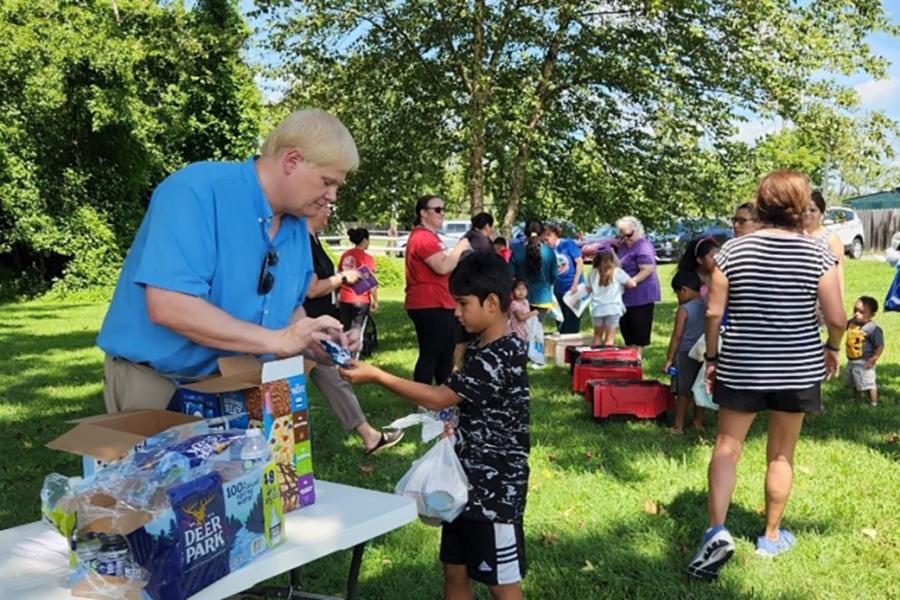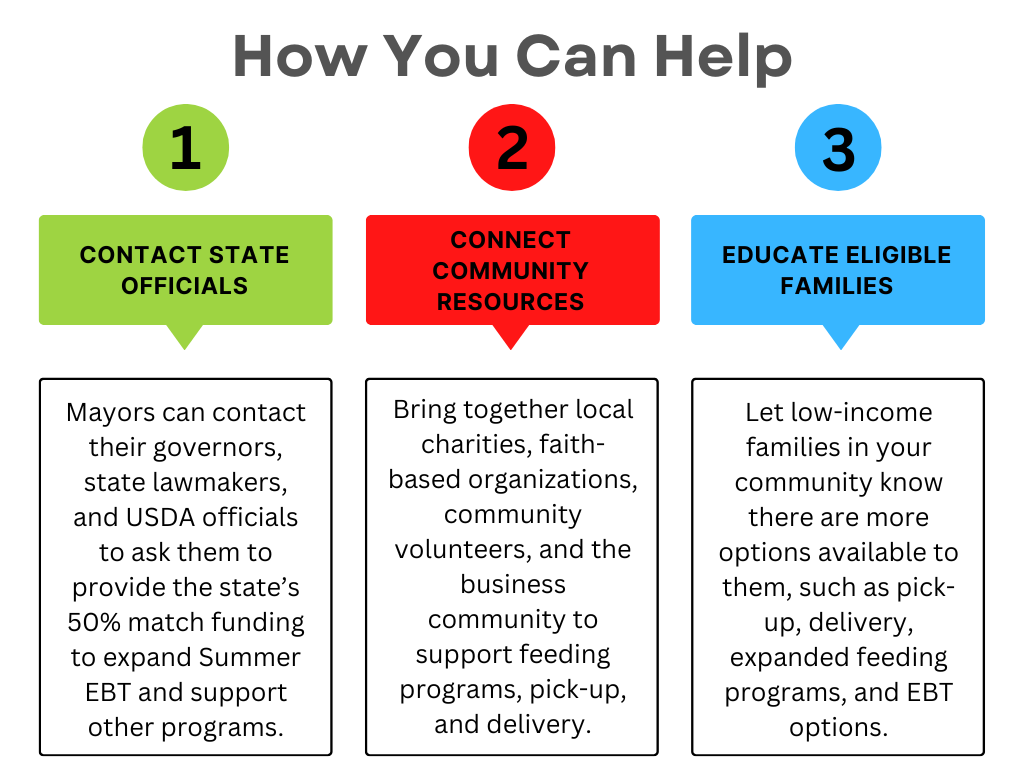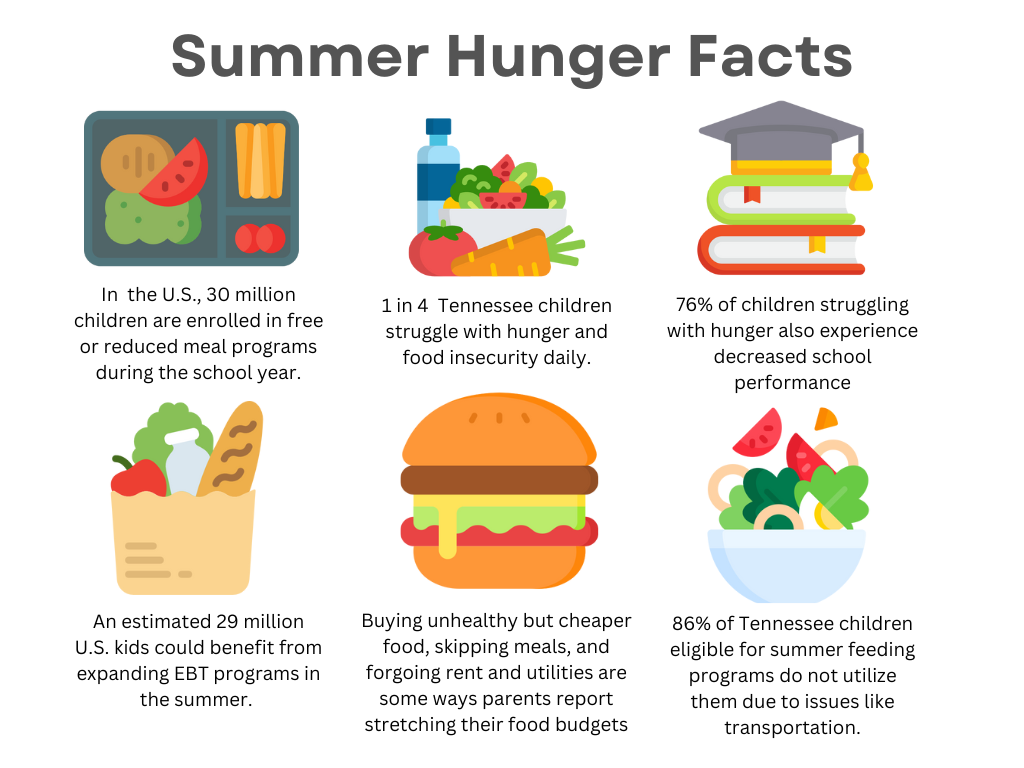Mayors can play vital role in ending summer hunger for kids

By KATE COIL
TML Communications Specialist
Mayors are being asked to lead the charge to defeat childhood hunger across America by promoting new programs in their cities.
More than 30 million American children participate in the USDA’s school breakfast and lunch program, but many of those lose access to healthy meals when schools are closed, particularly during the summer. Lessons learned from the pandemic prompted Congress to pass a bipartisan piece of legislation aiming at closing gaps in summer food programs, including the expansion of the traditional summer feeding programs, new to-go and delivery options in rural communities, and increased EBT benefits for families with children during the summer months.

To take advantage of these programs, however, states have to offer match funding to federal money. The Mayors Alliance to End Childhood Hunger is calling on mayors and city leaders from communities big and small to contact their governors and state policymakers about participating in these programs, help connect their local community organizations with summer feeding programs, and educate qualifying citizens on how they can benefit from these programs.
Mayors Alliance Chair and Mesa, Ariz. Mayor John Giles said through his leadership with the organization he has seen ending childhood hunger is a non-partisan issue impacting cities of all sizes.
“This is truly a solvable problem,” Giles said. “There is no excuse for children to go hungry in our country or in our cities. As mayors, we are uniquely situated to unite our communities to solve these challenges. Recently, the White House issued a challenge to us to convene in our cities the movers and shakers that can address this issue. That’s the thing we are best at. The meeting I sponsored here in Mesa was a gamechanger and really elevated our response. I hope you each take that opportunity, because you know better than anyone the people in your community who can address this.”
Alberto Gonzalez, a senior advisor with USDA’s Food and Nutrition Service (FNS), said the bipartisan omnibus bill passed last December marks the first time Congress has allowed states to offer expanded EBT services for children in need during the summer months as well as the first new, permanent USDA program in 40 years.
There are three new programs that are options for communities including an expansion of the traditional summer feeding programs; grab-and-go or delivery programs for rural communities; and a summer EBT program that will expand EBT funds by providing an additional $40 per child per month during the summer months to balance the loss of school meals.
“Summer hunger and summer learning loss impact too many kids across the nation when they lose access to nutritious school meals, meals that nearly 30 million children rely on throughout the school year,” Gonzalez said. “This is a remarkable opportunity to address childhood hunger at scale and to use all our tools to ensure no child goes hungry over the summer.”

Liz Campbell, branch chief with USDA-FNS and a registered dietitian, said children need to be supported year-round.
“We know children need consistent access to nutritious food to grow, learn, and thrive,” Campbell said. “Addressing summer hunger is something we all want to accomplish. For children, food insecurity is particularly devastating, and especially as mayors, I think it’s important to start with the framing that not having enough healthy food can have serious implications for a child’s physical and mental health, academic achievements, and future economic prosperity.”
While traditional feeding programs offer vital nutritious meals, physical activities, and programming that counters summer learning loss, there is a gap in services, particularly for children in more rural communities due to issues like transportation and staffing. The rural pick-up and delivery services as well as summer grocery benefits through EBT are two new tools designed to help fill these gaps.
“We witnessed during the pandemic the difference that can be made providing delivery and pick-up for rural families,” Campbell said. “This addresses issues like lack of transportation, staff, and funds. We started this new option this past summer, which provides equitable access to children across the country during the summer. It could benefit up to 8 million children in rural America, which is equivalent to filling up the Kansas City Chief’s stadium a little more than 100 times.”
The summer EBT program could benefit 29 million children across the country. Benefits will be based on food prices each summer and will be provided in addition in-person and grab-and-go or delivery options to fill any gaps. In addition to addressing food insecurity, studies have shown the summer EBT program can also bring federal dollars into the local economy through stores that provide EBT grocery services.
“We know summer EBT works,” she said. “We have had rigorous evaluation that has found it has reduced food insecurity and also increased diet quality. It’s critical to note it is not just addressing food inequality but improving nutrition as well.”

There are three major ways that local mayors can help implement these programs in their own communities: asking lawmakers and legislators to approve the 50% administrative match required for the summer EBT program, bring together local organizations and volunteers to bring the programs to their communities, and raising awareness among families in need that these programs are now available to them.
Gonzalez said securing funding is the first step in making sure these gaps are filled.
“It is critical that mayors call on their state leaders to prioritize match funding for summer EBT programs and administration as soon as possible so states begin operations next summer,” he said. “Understand you don’t have to do this alone. Know that you can partner on community, faith-based, business, and philanthropic leaders who can also serve as powerful voices behind securing funding for state EBT.”
Campbell said focusing on the “why” of the program is an important conversation to have with state leadership.
“We know this is what is best for kids,” she said. “If there is one thing I know, anyone who is working in summer childhood hunger issues wants to do what’s best for kids. We can refocus the conversation on what is best for kids and how we can work through the challenges to make that happen.”
Gonzalez said mayors are a powerful voice for educating community members on these programs.
“We know mayors are trusted messengers within a community,” he said. “We hope you can get the word out this spring ahead of the summer so all those eligible for these programs are aware and take advantage of them. I also ask that as you help bring down these barriers you keep in mind the potentially profound impact we can have on children if we do this right.
For more information and resources to help end child hunger, contact Tennessee USDA officials, visit No Kid Hungry, or get involved with The Mayors Alliance to End Child Hunger.

